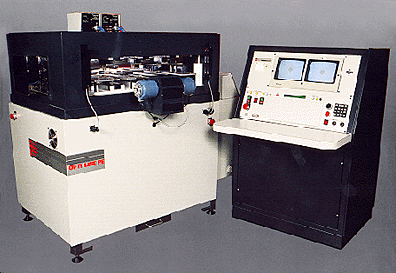
An advanced system for precise Post-Etch Punching of Inner Layers-Automated Flexible, Easy to Use
How does it work? Initial positioning is done by first locating the panel against left and rear material stops, either manually, or by automatic loader. Then the material crowders align the panel so that targets etched on the panel are within view of the video cameras. The panel is held in place on the positioning table by a cushioned top platen, and air target clips insure that the targets are held in proper focus.
Precise Image alignment is achieved by means of two high-resolution, CCD, miniature video cameras. Fiber optic light sources illuminate either the top or bottom of the panel, depending on the type of material being processed. Based on the cameras "seeing" the two targets etched on the panel, the micro processor directs the "X", "Y", "Ø" rotary positioning table to position the table. An algorithm is used whereby any deviation in target locations due to dimensional changes in the material or the phototool are averaged, and the system splits the difference, automatically. This results in optimum positioning of the panel. The normal accumulation of tolerance errors, which can cause a finished board to be useless, is avoided.
Precision punching of the tooling slots or holes in the panels occurs once the system is correctly positioned. The standard Optiline PE uses the conventional four-slot, center-zeroing, tooling configuration. Additional holes or different configurations can be accommodated. After punching an optional unloader can feed the panel out of the rear of the punch ready for the next operation. An automatic load and unload feature is also available for operator-free processing. The OPTILINE PE's SPC PACKAGE provides a real time statistical process analysis of production lots. The "spread" (stretch or shrink compared to the reference targets) is shown on the LCD display, in mils or millimeters. The system continually updates and displays the average spread value deviation as the run progresses. This allows definition of a maximum allowable spread. Panels which exceed this maximum spread will not be punched.
Applications for the SPC Package includes:
At the end of a run, a summary report provides:
Home | About Us | Staff | Directions | Products | News | Trade Shows | Literature | Employment | Contact Us
© 2002 Multiline Technology
|
